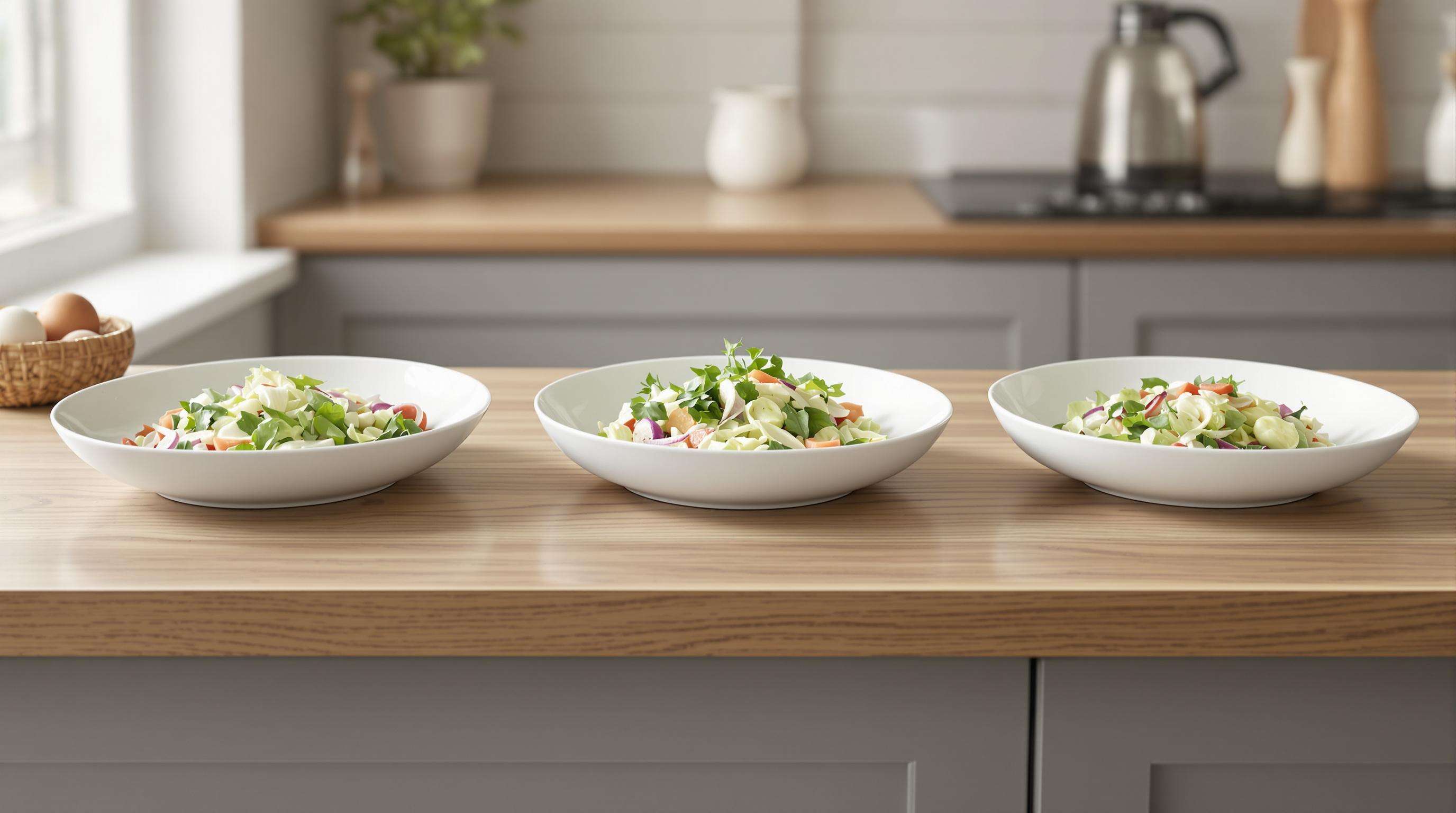Beautiful Ceramic Salad Plate Sets That Match Your Kitchen
Why Ceramic Salad Plate Sets Are a Modern Kitchen Essential
The Growing Popularity of Ceramic Salad Plates in Contemporary Homes
Ceramic salad plates are really taking off these days and have become must haves in many modern kitchens because they look great and work well too. People who own homes want dishes that combine classic beauty with stuff that actually works day after day, and ceramics hit that sweet spot. With those big open kitchens where the kitchen area flows right into the living room space, these plate sets double as pretty decorations that go just as well with a quick lunch as they do at fancy dinner gatherings. The way ceramic holds heat is pretty impressive too, staying warm about 27 percent longer than plastic ones according to some research from Material Science Digest back in 2023. This means greens stay fresh longer without losing their taste, which makes sense why so many folks now consider ceramic plates essential for their stylish but practical home environments.
How Ceramic Enhances Both Aesthetic and Functionality
Ceramic tableware really takes dining to another level because of how it's made. The surface doesn't absorb stains from red sauces or vibrant dressings, so those fancy plates stay looking fresh even after multiple trips through the dishwasher. Compared to heavier stoneware options, ceramic is surprisingly light while still being tough enough for everyday use. When it comes to presentation, different glazing methods create amazing textures and colors that make cheese boards and appetizer platters look restaurant quality. Another thing worth mentioning is how ceramic handles temperature changes. It spreads cold evenly across the surface, which means no sad wilted greens on one side while everything else stays crisp. For people who care about both looks and function at the table, ceramic combines these elements better than most materials available today.
Trend Spotlight: Color, Finish, and Design Trends in Ceramic Salad Plate Sets
Design trends today love contrasts between extremes. Think simple matte white surfaces sitting alongside vibrant glazed patterns that let people express themselves through color choices. Most eco-friendly kitchens stick to earthy tones these days, but there's something really clever about those speckled finishes too they just don't show scratches from daily use as much. Rimless plates and bowls are becoming pretty common because they look so clean and take up less space when stacked away. The Tabletop Design Index shows some interesting numbers for 2024 organic, irregular shapes have seen a 45% jump in popularity lately, which is shaking up what we expect from our dinnerware collections. Manufacturers are getting creative with modular sets too, letting folks combine different pieces without everything looking mismatched. Ceramics still holds its own in kitchen design despite all these changes, proving it can keep pace with modern tastes while staying functional.
Ceramic vs. Other Materials: Why Choose Ceramic Salad Plate Sets

Navigating dinnerware options for your kitchen? Understanding material differences helps select the right ceramic salad plate sets.
Comparing Ceramic, Stoneware, and Porcelain for Salad Plates
Ceramic sits somewhere in the middle ground between stoneware's rugged strength and porcelain's fancy appearance. Stoneware dishes tend to handle heavier foods just fine, while ceramic plates with their thinner design work great when serving salads or lighter fare. Porcelain definitely looks fancy on the table, no doubt about it, but those delicate pieces chip pretty easily during everyday use. Ceramic manages to offer similar classiness without breaking the bank, making it practical choice for folks who want something nice looking but won't cost an arm and a leg for regular meals around the house.
Durability, Heat Retention, and Daily Use Performance
Ceramic actually holds up pretty well against chips compared to fine porcelain when given some basic care, and tends to stay strong as time goes on. One thing people often overlook is how good it is at keeping things at their desired temperature. Cold stuff stays cold, hot food stays warm makes all the difference for those salads straight from the fridge or side dishes that need to stay heated through dinner. The mid weight options are solid enough to stack without worry, but what really stands out are the high fired ceramics. These bad boys can take about 30 percent more trips through the dishwasher than regular stoneware, so they end up being worth the extra cost if someone wants something that lasts for years rather than months.
Sustainability Advantages of Ceramic Dinnerware
Ceramic comes from natural earth minerals rather than plastic, so it doesn't leave behind those tiny plastic particles we're hearing so much about these days. Manufacturers are now adopting more efficient kilns and working with recycled clay materials, which cuts down on environmental damage somewhere around 35 to 40 percent when compared to older manufacturing techniques. These items can last for generations too. People pass down their favorite mugs and plates through families because ceramic actually breaks down safely over time without harming the environment. This makes sense for anyone trying to cut back on single use products that just end up in landfills after a few months.
Design Harmony: Matching Ceramic Salad Plate Sets to Your Kitchen Style
Minimalist Kitchens and Sleek Ceramic Plate Designs
Ceramic salad plates with simple shapes and soft colors like gray, white, or light blue really stand out in minimalist kitchens. Plates with sharp edges or square corners look great in modern spaces, and the matte finish helps cut down on reflections which is super important in those big open concept areas where everyone can see everything. Most people who want to save space in their kitchen go for stackable designs that don't take up much room. According to a recent survey from Smithson Design in 2023, around 6 out of 10 homeowners prefer these compact options, so it makes sense why they're becoming so popular for keeping storage neat and tidy.
Earthy & Matte Finishes for Natural and Rustic Themes
Matte-finish ceramic plates in terracotta, olive green, or speckled earth tones complement wood countertops and natural textiles. These finishes resist fingerprints and pair beautifully with linen napkins or bamboo placemats. A 2023 survey found 48% of buyers prefer matte dinnerware for its understated elegance and adaptability across seasons.
Color Coordination Between Plates and Kitchen Decor
Apply the 60-30-10 rule: 60% dominant color (e.g., sage cabinets), 30% secondary tone (warm terracotta), and 10% accent (gold trim). Cobalt blue ceramic plates make a striking statement against neutral backsplashes, while blush pink sets soften industrial-style spaces.
Mix-and-Match Styles for a Personalized Table Setting
Create dynamic tablescapes by combining:
- Contrasting shapes: Round dinner plates with hexagonal salad plates
- Complementary textures: Glossy and matte finishes in the same color family
- Pattern layering: Subtle embossed borders with solid-color bowls
Industry reports show a 55% increase in mix-and-match purchases since 2022, driven by demand for customizable, expressive dining experiences.
From Everyday Meals to Entertaining: Versatile Aesthetic Uses
Ceramic’s chip-resistant durability (four times stronger than standard stoneware) and extended heat retention (up to 40% longer than porcelain) make it ideal for both weeknight dinners and holiday gatherings. Neutral base sets allow for seasonal updates pair with autumn-themed linens or citrus-toned accents to refresh your table year-round.
Key Functional Features to Consider When Buying Ceramic Salad Plate Sets

Understanding Plate Shapes and Sizes: Salad vs. Side vs. Dinner
Most ceramic salad plates come in around 8 to 9 inches across, which puts them somewhere between dinner plates that are usually 10 to 12 inches and those tiny side plates measuring just 6 or 7 inches. The gentle curve on salad plates actually does a good job keeping dressings from spilling over, whereas side plates tend to be flat enough for things like small condiments or pickles. If someone wants their tableware collection to work well for different occasions, going with a set that has standard sizes makes sense since they'll stack together nicely without taking up too much space. A recent look at what's trending in tableware back in 2024 showed something interesting: nearly three quarters of homes now go for these multi sized ceramic collections because they handle all sorts of meals from casual snacks to full dinners.
Weight, Rim Design, and Stackability for Practical Use
Lightweight ceramic plates (1–1.5 lbs) reduce wrist strain during serving, while wide, tapered rims help prevent spills. Stackable designs save up to 30% more cabinet space than irregular sets. Avoid ultra-thin rims, which are 23% more prone to chipping based on durability testing.
Balancing Affordability with Quality and Craftsmanship
High-fire ceramic (fired at â¥2200°F) lasts 5–7 years longer than low-fire alternatives. Artisanal hand-painted sets range from $8–$12 per plate, while machine-made options offer similar chip resistance at $3–$5 per plate. Uniform glaze application is a reliable indicator of manufacturing precision and long-term performance.
Microwave, Dishwasher, and Chip Resistance: What to Look For
Choose ceramic labeled microwave-safe (free of metallic accents) and dishwasher-safe (with verified glaze integrity). Chip-resistant edges reduce replacement frequency by 41% (Ponemon 2023). Top-rated sets maintain appearance after 14+ dishwasher cycles, as confirmed by rigorous kitchenware testing.
| Feature | Ideal Specification | Performance Benefit |
|---|---|---|
| Thickness | 4–6 mm | Optimizes heat retention and chip resistance |
| Rim Design | Beveled or rolled edges | Reduces chipping during stacking |
| Glaze Type | Lead-free, non-porous | Prevents staining from acidic dressings |
For most households, a 12-piece set (4 dinner, 4 salad, 4 side plates) meets 85% of daily and entertaining needs while maximizing storage efficiency.
FAQ Section
Why are ceramic salad plates considered a kitchen essential?
Ceramic salad plates are considered a kitchen essential because they combine aesthetic appeal with practical functionality, retain heat efficiently, and complement modern kitchen designs.
How do ceramic plates compare to stoneware and porcelain?
Ceramic plates offer a balance between the durability of stoneware and the elegance of porcelain, making them a practical choice for serving lighter foods without the risk of chipping.
What are the sustainability benefits of using ceramic dinnerware?
Ceramic dinnerware is sustainable because it is made from natural minerals, reduces plastic waste, and manufacturers use more efficient production techniques to minimize environmental impact.
Which design trends are popular in ceramic salad plates?
Popular design trends in ceramic salad plates include earthy and matte finishes, organic shapes, and mix-and-match styles that allow for personalized dining experiences.
What should I consider when buying ceramic salad plate sets?
When buying ceramic salad plate sets, consider factors like plate sizes, stackability, craftsmanship, microwave and dishwasher safety, and chip resistance to ensure quality and practicality.
